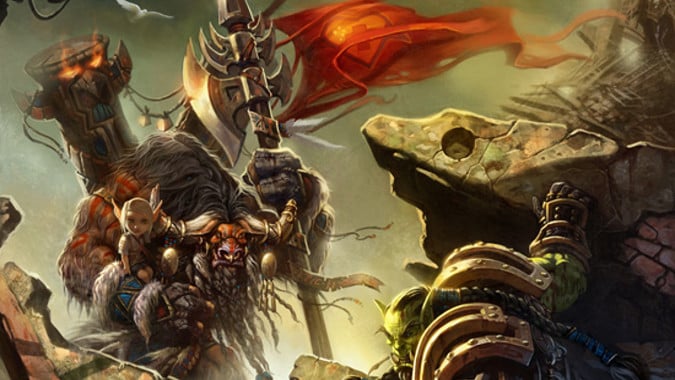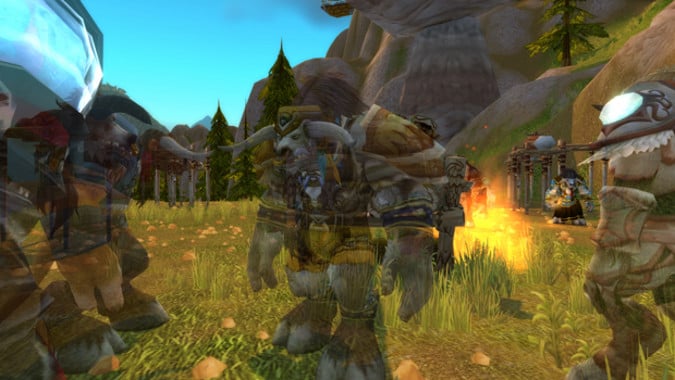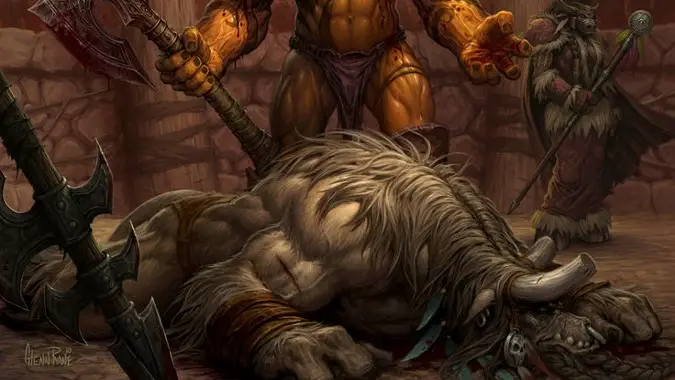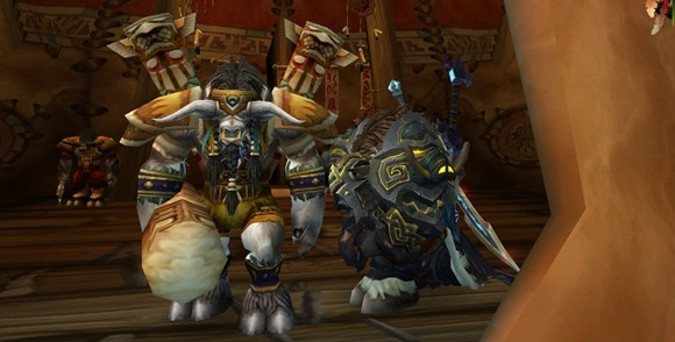Know Your Lore: The life and death of Cairne Bloodhoof in WoW
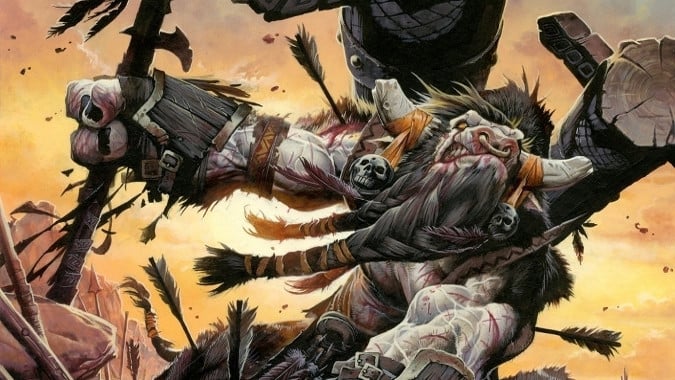
When we last left our look at the Old Bull’s life we were at the end of the Horde battle in Dustwallow Marsh against Daelin Proudmoore. This was the end of the beginning of the new Horde established by Thrall, a collection of misfits who found unity in the shared values and purpose each held. For Vol’jin, Thrall, and Cairne all wanted to protect and safeguard their people and see a new future for them.
Cairne returned to Mulgore even more convinced that the Horde was his people’s future — that in addition to the great debt the Tauren owed the Orcs for their aid in traveling out of the Barrens, the Tauren now had shown their potential and in aiding the Orcs against the Humans of Daelin Proudmoore’s forces had made it clear that they each had much to offer the other. Similarly, having fought alongside Vol’jin and his Darkspear Trolls, Cairne now saw similarities that could be used to bridge the gap between them — both Tauren and Trolls had joined the Horde after Thrall had interceded to aid them against powerful enemies, after all. It was clear to Cairne’s eyes that the Shu’halo would be better for their participation in the Horde.
So when he returned to Mulgore, he took steps to ensure that his people would have a future.
The building years
More and more of the Shu’halo came to Mulgore as the years passed, disparate tribes from all over Kalimdor from Feralas and Desolace to Thousand Needles and the Barrens. Even the contentious and (some argued) bigoted Grimtotem tribe saw that in Mulgore, Cairne was creating an entirely new way of life for the Tauren, and representatives of every tribe came to live in the mesa-top city of Thunder Bluff as it was constructed. Not everyone believed that Cairne was right in his belief in the Horde, but all accepted his wisdom and knew that the old ways of wandering the surface of the Earthmother hadn’t prepared their people adequately for the kinds of threats they’d faced in the recent past.
Following the Third War, Cairne’s old friend Hamuul Runetotem had struck up a friendship with Malfurion Stormrage, and his return from spending time being instructed by Shan’do Stormrage saw Cairne’s people learning the arts of the Druid, a path that many believed they’d walked once before, in the distant past. The return of these magics was seen as a good omen, that the newly appointed High Chieftain of Thunder Bluff was on the right track. Of course, not all thought so, but while Magatha Grimtotem and her tribe viewed Cairne as a doddering old fool, none were particularly eager to attempt to wrest control of Thunder Bluff from the Old Bull. Gray in the beard he might have been, but none questioned his raw power. To battle Cairne Bloodhoof, you would need a way to even the odds against him.
While they would find a way eventually, the next few years they bided their time.
The rise of conflict
Those years would be tumultuous, but much of the tumult would take place on the Eastern Kingdoms, far away from Kalimdor and Mulgore. Cairne led his people as the Horde and Alliance fought each other and menaces that threatened both, such as Ragnaros the Firelord in the Molten Core, the Brood Mother Onyxia in her lair in Dustwallow Marsh, her diabolical sibling Nefarian at the heights of the Blackrock Mountain, and when the Horde and Alliance joined forces to do battle with the Silithid and their Qiraji masters in Ahn’Qiraj. During this time Cairne made extensive use of the Longwalkers, Tauren scouts who were his eyes and ears throughout Kalimdor, reporting only to him.
It was not until the return of the Lich King that the Tauren began to feel the weight of the choice their High Chieftain had made, as many young Tauren went to Northrend to do battle with the Scourge. Some didn’t return. Others returned changed, and Cairne was troubled by the cost his people were paying. He understood that it had to be paid, however. When his people discovered the arts of the Sunwalker and the Priest, proving the Tauren talent for adaptability, Cairne accepted these new paths for his people.
The death of the Old Bull
When the war against the Lich King finally ended, Cairne was the one chosen to travel to Northrend and retrieve Garrosh Hellscream, to return the young warleader to Orgrimmar. While Cairne was impressed with Garrosh as a general, he was less impressed with Garrosh as a potential leader for his people. When the Elemental Unrest began and Thrall made his plan to leave the Horde in Garrosh’s hands clear to Cairne, the Old Bull objected strenuously. Garrosh was a fine warrior and a talented (one might even say devastating) tactician, but he was no fit choice to replace Thrall. He understood nothing of the complicated diplomacy that held the disparate races of the Horde together. In the time that Thrall had been Warchief the Horde had transformed from a band of Orcs seeking to escape Lordaeron to a vast organization capable of waging war globally, made up of many different peoples united in common cause. The Horde wasn’t just Orcs anymore, and Cairne saw nothing in Garrosh to indicate he understood that crucial difference.
Cairne refused to endorse Thrall’s plan, and the two parted angrily. Hamuul Runetotem and Cairne met and discussed how Garrosh was reconstructing Orgrimmar in jagged iron spikes, a more suitable capital city for the Old Horde than the organization Thrall had created. Hamuul left to attend a meeting of Druids in Ashenvale, only to be ambushed and nearly killed by Twilight’s Hammer who deliberately let the Archdruid see their Orcish members in order to convince him that Garrosh was responsible for the attack. Hamuul’s survival was a near thing, and he therefore was in Camp Taurajo recovering when Cairne heard the news. Enraged by this and Garrosh’s overall attitude as leader, Cairne would have no more of it. He challenged Garrosh to a Mak’gora, an honor duel from the time of the Old Horde that Thrall had changed to a non-lethal combat. Garrosh replied that he would accept the challenge, but it would be to the death in an attempt to intimidate Cairne into backing down.
Cairne did not back down.
On the day of the Mak’gora, unbeknownst to either combatant, the elder crone Magatha Grimtotem blessed Garrosh’s weapon Gorehowl. This meant that a grazing wound to Cairne’s chest resulted in near paralysis, and so, Garrosh won the Mak’gora, slaying Cairne in the process. Thus the Old Bull’s life ended, not in a fair combat but via treachery and the recklessness of an upstart. Later, even Garrosh would admit that due to Magatha’s actions, he’d never know if he could have defeated Cairne fairly.
It is my opinion he could not.
The legacy of the High Chieftain
Cairne’s son Baine managed to defeat Magatha’s Grimtotems when they took the opportunity of Cairne’s death (which of course they’d expected, since their Elder Crone was the one who’d poisoned him) to rise against the other Tauren and seize Thunder Bluff. Rather than executing Magatha, Baine chose to live in his father’s example and spared her life, banishing her and those Grimtotem loyal to her from the rest of Tauren society. Baine’s leadership of the Tauren since his father’s death has very much been influenced by what he felt his father would do, or in an attempt to either honor or avenge him, such as when he joined Vol’jin’s Darkspear Rebellion. Baine’s decision to defend Garrosh Hellscream at his trial in Pandaria came from a meeting with Cairne’s spirit, summoned by Kador Clousong.
The Tauren as they are today — a settled people living in Mulgore, their technical precision visible in their great lifts and the architecture of Thunder Bluff — are Cairne’s children, all. His people are defined by his decisions, his choices, and his sacrifices. They honor him, for he gave them everything he had.
Please consider supporting our Patreon!
Join the Discussion
Blizzard Watch is a safe space for all readers. By leaving comments on this site you agree to follow our commenting and community guidelines.
 @MatthewWRossi
@MatthewWRossi